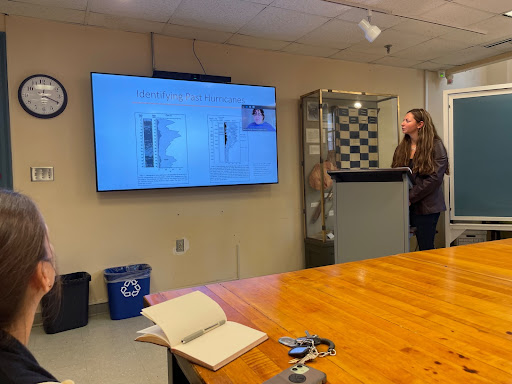Wednesday, Nov. 8th, the College of William and Mary’s department of anthropology hosted a Brown Bag Lecture titled “Connecting Climate Pasts and Presents in the Caribbean.” Third-year doctoral student Caroline Watson hosted University of Maine second-year anthropology doctoral student Karina Cortijo-Robles and University of Maine professor of anthropology and quaternary and climate studies Dr. Daniel H. Sandweiss via Zoom for a hybrid lecture.
Sandweiss and Cortijo-Robles initially began collaborating over a shared interest in human responses to unprecedented climate change, specifically regarding hurricanes and the El Niño climate pattern. Cortijo-Robles and Watson focused on its effects in the municipality of Ponce in southern Puerto Rico.
Watson began the presentation by underscoring their goals.
“As archaeologists, we are interested in not just the material correlates of climate change, but more so, how climate becomes a social phenomenon when you consider the ways that it conditions the relationships that people form between each other and between the landscape,” Watson said. “And how climate shapes peoples’ lives and allows people to innovate resilience in relation to weather.”
According to Watson, climate change is not a new phenomenon for civilization. Archaeological records give anthropologists a better understanding of how past humans dealt with similar environmental changes and offer potential insights for contemporary solutions.
“We need to understand the relationship between climate, environment and climatic change, and human society,” Sandweiss said. “And it’s a very complex relationship, difficult to get at today, much less through the material remains we have of the past.”
Sandweiss then presented a spreadsheet of past El Niño activity by novel climate proxies located in archaeological sites. He described how anthropologists use proxies in relation to data for climate observations.
“They allow us to understand aspects of climate that might not be visible in other ways, and they let us understand those climatic events and changes in frequencies and changes in frequency and intensity of events in direct association with what peoples of the past were doing, which is also critical for understanding the relationship between people and climate,” Sandweiss said.
By documenting previously unknown data through climate proxies, Sandweiss contributes to improving climatologists’ ability to forecast future weather patterns.
“The best thing that we can do with climate change is have hope that we can do better and we will do better and start working on it,” Cortijo-Robles said. “And never, never stop talking about it.”
Cortijo-Robles, a Puerto Rico native, also expressed interest in paleotempestology, the study of past tropical cyclone activity, as a tool for understanding her community’s ongoing relationship with extreme weather. Her working doctoral thesis delves into the interactions between hurricane activity of the past and the responses of Indigenous peoples in Puerto Rico.
Around the year 1200, there was an unexplained abandonment of the current Tibes Indigenous Ceremonial Center near Ponce after three-hundred years of occupation. Cortijo-Robles and her team believe a considerable change in weather may have played a part in the site’s abandonment.
To analyze her initial proposition, one of Cortijo-Robles’s first goals was to verify that hurricanes of present-day magnitude occurred in the past as part of Earth’s ever-changing climate. Using data from the National Oceanic and Atmospheric Administration, she reconstructed a graph illustrating the trajectories of hurricanes affecting Puerto Rico from 1898-2022, analyzing clear patterns of behavior.
Cortijo-Robles and her team have begun studying sediment erosion in the nearby Portuguese river to further confirm these patterns.
“So usually the direct observation is the soil samples or sediment cores that we picked from the coast,” Cortijo-Robles said. “And also we have indirect observation in Tibes. With those old sediment cores, we’re trying to identify those hurricane signatures and maybe try to understand how Indigenous populations were responding to them.”
As for the larger intentions behind her work, Cortijo-Robles hopes to have present-day locals see reflections of themselves in historical documentation of Indigenous responses to their shared world.
However, documenting archaeological data is a time-sensitive process, as hurricane and storm activity jeopardizes the longevity of sites in numerous ways.
“So at one end, you do have archaeological material being eroded, being physically altered, being submerged,” Watson said. “But, also equally powerful are the anthropogenic impacts or how human response to climate change is affecting anthropological material. So things like sand mining, to literally dig out sand and transfer it to build dunes in front of peoples’ homes. That’s at risk of uprooting sites.”
Additionally, colonization’s impact on the region’s infrastructure has not supported sustainable practices in the past. For example, the non-endemic shallow-rooted Coconut Palm tree brought by Spanish colonizers is quickly uprooted by high winds. The trees have since been able to multiply the impact of landslides.
To enhance the dependability of their constructed environment, Watson recommended local resources with historical patterns of resilience.
“I think we need to more seriously incorporate these forms of knowledge that are informed by peoples’ lived experience into archaeological mitigation practices,” Watson said. “So, the case here always helps us link the ongoing impacts of climate change and extreme weather to Puerto Rico’s relationship with colonialism.”
Through archaeological studies such as Sandweiss and Cortijo-Robles’s work, the documentation of past successes and shortcomings in response to climate introduces an alternate way of conceptualizing approaches for the future.
“The best thing that we can do with climate change is have hope that we can do better and we will do better and start working on it,” Cortijo-Robles said. “And never, never stop talking about it.”

